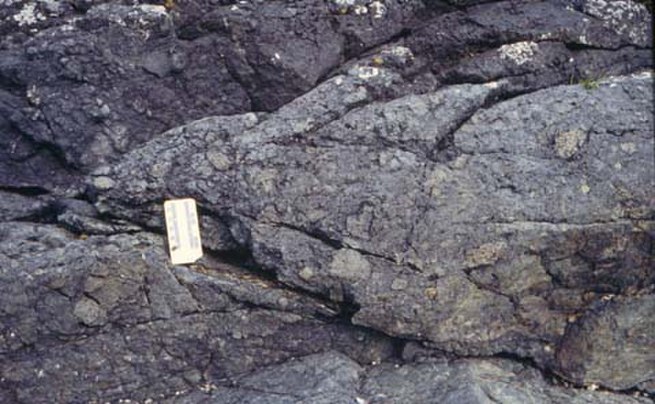
-
Agglomerate
Agglomerate (from the Latin agglomerare meaning “to form into a ball”) is a coarse accumulation of large blocks of volcanic material that contains at least 75% bombs. Volcanic bombs differ from volcanic blocks in that their shape records fluidal surfaces: they may, for example, have ropy, cauliform, scoriaceous, or folded, chilled margins and spindle, spatter, ribbon, ragged, or amoeboid shapes. Globular masses of lava may have been shot from the crater at a time when partly molten lava was exposed, and was frequently shattered by sudden outbursts of steam. These bombs were viscous at the moment of ejection and by rotation in the air acquired their shape. They are commonly 1 to 2 feet (30 to 60 cm) in diameter, but specimens as large as 12 feet (3.7 m) have been observed. There is less variety in their composition at any one volcanic centre than in the case of the lithic blocks, and their composition indicates the type of magma being erupted.
Agglomerates are typically found near volcanic vents and within volcanic conduits, where they may be associated with pyroclastic or intrusive volcanic breccias. Older (pre-1970) publications, particularly in Scotland, referred to any coarse-grained volcaniclastic rock as ‘agglomerate’, which led to debris flow deposits, talus deposits and other types of breccia being mistaken for vents. Agglomerates are typically poorly sorted, may contain a fine ash or tuff matrix and vary from matrix to clast support. They may be monolithologic or heterolithic, and may contain some blocks of various igneous rocks. There are various differences between agglomerates and ordinary ash beds or tuffs. Agglomerates are coarser and less frequently well-bedded. Agglomerates can be non-welded or welded, such as coarse basaltic ‘spatter’. They typically form proximally during Strombolian eruptions, and are common at strongly peralkaline volcanoes. Some large agglomerate deposits are deposited from pyroclastic density currents during explosive caldera-forming eruptions, such as at Santorini, Taal, and Campi Flegrei. They may be massive to crudely bedded, and can attain great thicknesses.
Crystalline masses of a different kind occur in some numbers in certain agglomerates. They consist of volcanic minerals very much the same as those formed in the lava, but exhibiting certain peculiarities which indicate that they have formed slowly under pressure at considerable depths. They bear a resemblance to plutonic igneous rocks, but are more correctly to be regarded as agglomerations of crystals formed within the liquid lava as it slowly rose towards the surface, and at a subsequent period cast out by violent steam explosions. The sanidinites of the Eifel belong to this group. At Vesuvius, Ascension, St Vincent and many other volcanoes, they form a considerable part of the coarser ash-beds. Their commonest minerals are olivine, anorthite, hornblende, augite, biotite and leucite.
-
Conglomerate (noun)
A cluster of heterogeneous things.
-
Conglomerate (noun)
A formed by the combination of several smaller corporations whose activities are unrelated to the corporation’s primary activity.
-
Conglomerate (noun)
A rock consisting of embedded in a matrix.
-
Conglomerate (adjective)
Clustered together into a mass.
“conglomerate flowers”
-
Conglomerate (adjective)
Composed of fragments of rock, stones cemented together.
-
Conglomerate (verb)
To combine together into a mass.
-
Conglomerate (verb)
To combine together into a larger corporation.
-
Agglomerate (adjective)
collected into a ball, heap, or mass
-
Agglomerate (noun)
A collection or mass.
-
Agglomerate (noun)
A mass of angular volcanic fragments united by heat; distinguished from conglomerate.
-
Agglomerate (noun)
An ice cover of floe formed by the freezing together of various forms of ice.
-
Agglomerate (verb)
To wind or collect into a ball; hence, to gather into a mass or anything like a mass.
-
Conglomerate (noun)
a thing consisting of a number of different and distinct parts or items that are grouped together
“the Earth is a specialized conglomerate of organisms”
-
Conglomerate (noun)
a large corporation formed by the merging of separate and diverse firms
“a media conglomerate”
-
Conglomerate (noun)
a coarse-grained sedimentary rock composed of rounded fragments embedded in a matrix of cementing material such as silica
“the sediments vary from coarse conglomerate to fine silt and clay”
-
Conglomerate (adjective)
relating to a conglomerate, especially a large corporation
“conglomerate firms”
-
Conglomerate (verb)
gather together into a compact mass
“atoms which conglomerate at the centre”
-
Conglomerate (verb)
form a conglomerate by merging diverse firms
“the urge to conglomerate has long been out of fashion in American boardrooms”
-
Agglomerate (verb)
collect or form into a mass or group
“he is seeking to agglomerate the functions of the Home Office”
“these small particles soon agglomerate together”
-
Agglomerate (noun)
a mass or collection of things
“a multimedia agglomerate”
-
Agglomerate (noun)
a volcanic rock consisting of large fragments bonded together.
-
Agglomerate (adjective)
collected or formed into a mass.
